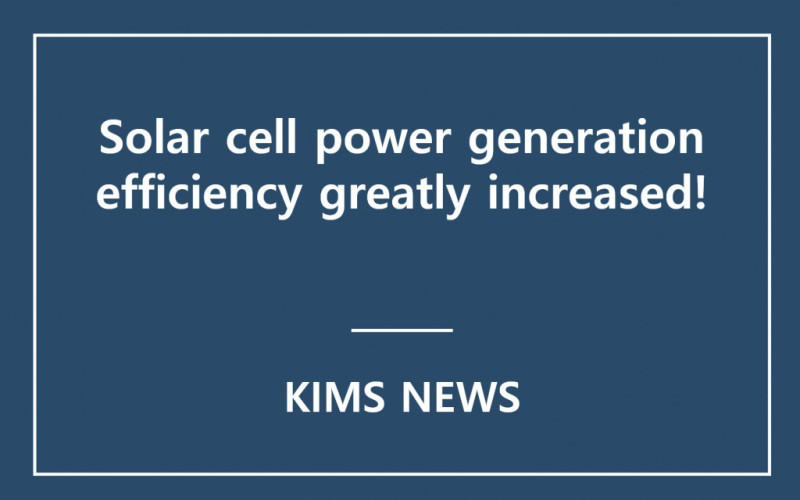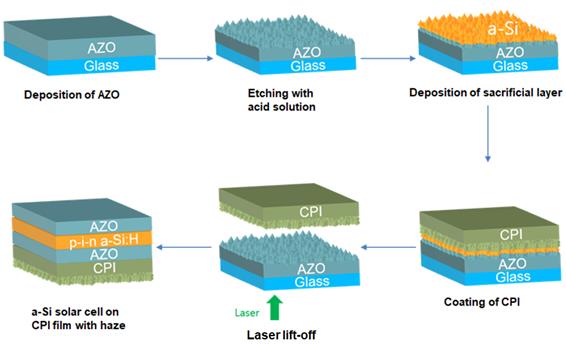R&D | KIMS, developed the world’s first flexible substrate transparent thin-film solar cell for BIPV with bifacial power generation
Page info
Date23-04-21 14:09 Hit252Link
Contents
Solar cell power generation efficiency greatly increased! |
A research team led by Dr. Jung-dae Kwon of the Surface & Nano Materials Division at the Korea Institute of Materials Science (KIMS), a government-funded research institute under the Ministry of Science and ICT, together with Professor Pung-keun Song of Pusan National University and Professor Myung-hun Shin of Korea Aerospace University, developed a flexible substrate incorporating light-scattering structures through a transfer process using a laser lift-off. Through this refractive index matching, the light reflection on the back side was minimized, and it succeeded in implementing the world’s first flexible substrate transparent thin-film solar cell with high bifacial power generation.
Since the light absorption layer of the transparent thin-film solar cell has an extremely thin thickness of 300 nanometers (nm) or less, a light scattering structure is introduced to increase the amount of current generated. So far, research has been mainly used to create and generate light-scattering structures using the etching and photolithography processes of transparent oxide semiconductors applied to solar cells. However, these processes have limitations in that it is difficult to apply to flexible substrates because the manufacturing process is complicated or is likely to have a high possibility of generating defects.
After depositing a laser absorption layer on a zinc oxide thin-film with a light-scattering structure, the research team manufactured a light-scattering structure with a flexible substrate having the same shape as the light-scattering structure on top of it, with a thickness of about 20 micrometers (㎛), developed and overcome the limitations of existing processes. At this time, the flexible substrate with a thickness of 20 micrometers formed showed a light-scattering rate of 51.9%, and the efficiency of the silicon thin-film solar cell formed on the opposite side was improved by 9.7% compared to the flexible substrate solar cell without light-scattering. This process can form solar cell substrates ranging in size from as small as 5x5 cm to as large as 14x14 cm, which is suitable for the existing solar cell processes by minimizing defects caused by the structure.
This technology increases the power generation efficiency of solar cells by transferring and fusing structures that effectively generate light scattering without reducing the transmittance of flexible substrates using lasers lift-off. In particular, since the solar cell device is grown on the opposite side of the light-scattering structure, defects due to the structure do not occur, and defects due to the inherent characteristics of the material can be minimized. Therefore, it is expected to be applied to various absorbers for thin-film solar cells and to be a measure of high efficiency for flexible substrate transparent thin-film solar cells for BIPV. In addition, it has secured a high level of bifacial power generation by reducing reflected light with a window layer design that minimizes the loss of incident light from the rear side.
Flexible substrate transparent thin-film solar cell technology can be attached to and developed to all elements that make up the building without additional material design to the existing building. It is expected to be able to effectively replace the solar cell market formed on glass/metal substrates with relatively high efficiency at a low cost compared to the existing ones. It is also expected to be applied to more diverse fields such as agricultural solar power generation.
Dr. Jung-dae Kwon, the principal researcher at KIMS, who is in charge of the research, said, “If this technology is commercialized, it will be possible to develop a light-scattering structure with flexible substrate transparent thin-film solar cell with no difficulties in the process, and to realize a BIPV system for bifacial power generation with an improved light absorption mechanism.”
With the support of the Ministry of Science and ICT, this research achievement was carried out through the major projects of the Korea Institute of Materials Science and the energy technology development project of the Korea Institute of Energy Technology Evaluation and Planning. In addition, the research results were published on March 27 in ‘npj flexible electronics (IF: 12.019)’, the top-notch journal in the field of electronic engineering and a sister journal of Nature (1st author: Soo-won Choi, co-author, Professor Pung-keun Song of Pusan National University and Professor Myung-hun Shin of Korea Aerospace University). Based on this study, the research team is currently actively conducting research in the field considering the aesthetic aspect as well as the efficiency aspect of BIPV using a flexible substrate.


